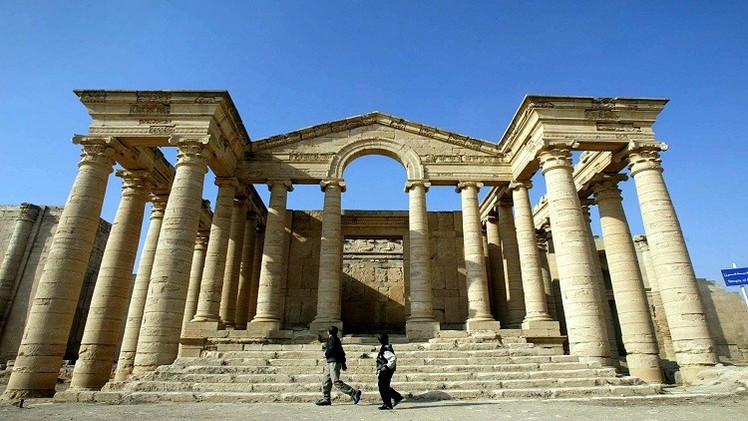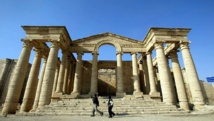HATRA
An extremely well-preserved fortress city in modern-day Iraq's Nineveh province that dates to more than 2,000 years ago. With a unique blend of eastern and western architecture, it is one of only four UNESCO world heritage sites in the country.
UNESCO condemned its reported destruction, but its fate remains unclear.
NIMRUD
An ancient Assyrian city south of Mosul on UNESCO's tentative world heritage list, founded in the 13th century BC and originally called Kalhu. According to the Iraqi government, IS militants bulldozed the site on March 5.
The UN's cultural body called the destruction a "war crime".
MOSUL MUSEUM
Iraq's most important museum after Baghdad's, it has four main halls. In a video released by IS on February 26, militants are seen using sledgehammers to smash statues -- some from Nimrud and from Hatra.
According to antiquities officials, around 90 objects were destroyed or damaged, most of them originals. The rampage was compared to the Taliban's 2001 dynamiting of the Bamiyan buddhas in Afghanistan.
NABI YUNUS SHRINE
On July 24, 2014, IS militants completely levelled Jonah's tomb, one of Mosul's best-known shrines also known as Nabi Yunus. They rigged the popular pilgrimage site with explosives and blew it up in front of a large crowd.
MOSUL LIBRARY
Thousands of books and rare manuscripts were burned in February. It is not clear what damage the library itself suffered, but UNESCO described the destruction of the books as a new phase in the jihadists' campaign of "cultural cleansing".
ABU TAMMAM'S STATUE
Abu Tammam was a ninth century Arab poet who lived in Mosul and wrote the Hamasah, a collection of 10 books of poems. His statue was taken down in June.
GREEN CHURCH
An important cathedral first established around 1,300 years ago in the city of Tikrit. Known as the "Green Church" or Mar Ahudama, it was the scene of a massacre of Assyrian Christians by Mongol invaders in 1258. It was destroyed in late September or early October.
SHRINE OF THE FORTY
In late September, the Shrine of the Forty (Arbaeen) in Tikrit was blown up. The monument marked the graves of 40 soldiers from the army of Caliph Omar ibn Khattab during the Islamic conquest of Mesopotamia in 638 AD.
------------------------------------------------------------------------------------------------------------
An extremely well-preserved fortress city in modern-day Iraq's Nineveh province that dates to more than 2,000 years ago. With a unique blend of eastern and western architecture, it is one of only four UNESCO world heritage sites in the country.
UNESCO condemned its reported destruction, but its fate remains unclear.
NIMRUD
An ancient Assyrian city south of Mosul on UNESCO's tentative world heritage list, founded in the 13th century BC and originally called Kalhu. According to the Iraqi government, IS militants bulldozed the site on March 5.
The UN's cultural body called the destruction a "war crime".
MOSUL MUSEUM
Iraq's most important museum after Baghdad's, it has four main halls. In a video released by IS on February 26, militants are seen using sledgehammers to smash statues -- some from Nimrud and from Hatra.
According to antiquities officials, around 90 objects were destroyed or damaged, most of them originals. The rampage was compared to the Taliban's 2001 dynamiting of the Bamiyan buddhas in Afghanistan.
NABI YUNUS SHRINE
On July 24, 2014, IS militants completely levelled Jonah's tomb, one of Mosul's best-known shrines also known as Nabi Yunus. They rigged the popular pilgrimage site with explosives and blew it up in front of a large crowd.
MOSUL LIBRARY
Thousands of books and rare manuscripts were burned in February. It is not clear what damage the library itself suffered, but UNESCO described the destruction of the books as a new phase in the jihadists' campaign of "cultural cleansing".
ABU TAMMAM'S STATUE
Abu Tammam was a ninth century Arab poet who lived in Mosul and wrote the Hamasah, a collection of 10 books of poems. His statue was taken down in June.
GREEN CHURCH
An important cathedral first established around 1,300 years ago in the city of Tikrit. Known as the "Green Church" or Mar Ahudama, it was the scene of a massacre of Assyrian Christians by Mongol invaders in 1258. It was destroyed in late September or early October.
SHRINE OF THE FORTY
In late September, the Shrine of the Forty (Arbaeen) in Tikrit was blown up. The monument marked the graves of 40 soldiers from the army of Caliph Omar ibn Khattab during the Islamic conquest of Mesopotamia in 638 AD.
------------------------------------------------------------------------------------------------------------









 Home
Home Politics
Politics











